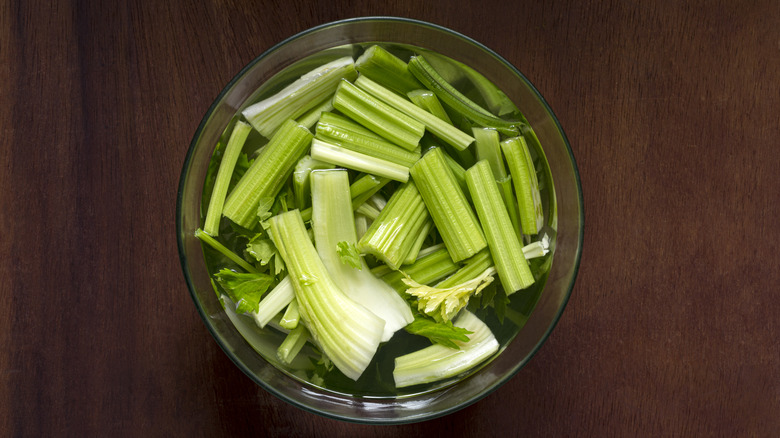Revive Limp Celery With This Clever Storage Trick
If you're going to serve up some delicious buffalo wings with celery, the last thing you want is to open your fridge and find your stalks dry and wilted. Unfortunately, celery is prone to drying out with age as it loses the moisture that keeps it crisp. While there are secrets to keeping celery crisp in the fridge (like using aluminum foil, for instance), if you've already got limp stalks on your hands, proper storage isn't going to do you much good. That said, not all hope is lost! When life gives you limp celery, you just need a bit of water to perk it back up.
The key to reviving limp celery is to either cut the bottoms off and submerge the stalks in cold water, or if you don't have a large enough container, place the stalks upright in a large glass or vase. Once in the water, the celery should be put back into the refrigerator overnight. The cold water will help rehydrate the dry celery and give it back its original crispness.
You can keep the celery stored in water for up to two weeks in the fridge, but remember to change the water every alternate day to prevent it from stagnating. This will allow you to keep a whole bunch of celery crisp so that you don't feel pressured to try and use it all at once. Seeing as most stores sell large bunches of celery, this is a great way to ensure that what you buy doesn't go to waste, and that when the urge to make a tuna salad sandwich with a celery upgrade strikes, you'll have some crisp and ready to use.
Why putting celery in water works
The reason why celery turns limp and rubbery is that it quickly dehydrates when not stored properly. Because celery is comprised of 95% water, the best way to bring it back to life is by rehydrating it.
When dry celery is placed in water, capillary action begins. This is when water is absorbed into thin tube-like structures in the stalk called xylems and moved upwards throughout the plant. As the water is distributed into the plant's cells through osmosis, they swell and become firmer. This creates something called turgor pressure, which is responsible for the structural stability of the plant. Think of it as you would a wilted house plant. A plant that isn't watered for a while will start to soften and wilt but perks up after a good watering. This is thanks to turgor pressure helping the plant become more rigid as water is absorbed.
As an aside, never place celery in heavily salted water to try and rehydrate it because this will actually have the opposite effect thanks to osmosis, the process through which water moves from areas of high to low concentrations. For example, fresh water moves into dehydrated celery because its cells have a low concentration of water. However, with salt water, it's the water from the celery that will diffuse into the fresh water because of the difference in salt concentrations between the two. Now, you can salt-cure celery, but this uses a precise ratio of salt to water to prevent the celery from turning limp.

